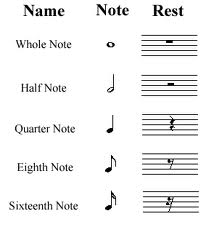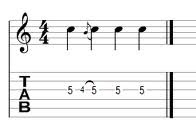Notes
The following notes exist: A, B, C, D, E, F, G. They repeat up and down on the scale (or piano).
These notes also have sharp and flat versions. It means that A♯ (i.e. A sharp) is half a note (step) high than A and A♭ (i.e. A flat) is half a step lower than A.
There are also "en-harmonic" notes. It means that there is a note that has two different names. For instance, A♭ is the same note as G♯. It's an identical note, however, you can "approach" it in two ways.
The Staff
The five lines that you see in the sheet music is called the staff. You can place notes ON the lines and BETWEEN the lines. Sometimes if there is a particularly high or low note, you can even add one or more short lines below or above the original five.
The staff always contains several measures (or bars) that divide the music into small, comprehensible pieces. These measures are divided by bar lines.
At the end of the song, there are two lines, a thinner and a thicker one. It means that the music ends there.
This is the most basic step in learning how to read music notes.
Time Signatures
Often you'll find a time signature at the beginning of the staff (right after the clef sign). There are always two numbers there, one on the top and one on the bottom.
The top number shows you the number of beats in each measure (or bar). The bottom number tells you what kind of note gets a full beat. It's all maths. The most common time signatures in popular music are 4/4 and 3/4.
Note lengths are one of the most important pieces of knowledge you can have if you want to learn how to read music notes. You'll find four main types of notes in sheet music. They show you how long you have to hold the notes when you play them:
If there is a 4/4 measure, for example, you can play any combination of notes as long as their values add up to 4 beats. You could play one half note (2 beats) and four eighth notes (another 2 beats) and this way get 4 beats. And you thought mathematics wasn't important for musicians? :)There are also so called "dotted notes". It's easy to recognize them: there is a little dot right after the note.
The dot increases the duration of the note by half of its original value. E.g. if a note lasts 2 beats, the dotted note lasts 2+1 that is 3 beats. Any number of dots may be added to a note, however, usually there is only one.Note: if we play several notes at the same time, we have a chord. More about chords and how to learn them in minutes here: Keyboard Chords
Key Signatures
You'll find the key signatures (a group of sharps and flats) at the beginning of the staff. They help you a lot in showing how to read music notes. Key signatures show you the key of the song and which notes are sharp or flat in that key. I've written a separate page about key signatures.
Octave Placement Notation
A piano contains 88 keys. That's a lot of octaves. And that's why sometimes you'll see octave placement notations in the sheet music. These signs are always followed by a dashed line which tell you how long this modification lasts.
Treble Clef
The treble clef is this famous and beautiful sign that you often see at the beginning of the staff (and as necklace pedants). It tells you what notes the different musical notes in that line correspond to.
The C that you can find on the first added (ledger) line below the lowest line in the staff is middle C. If you have a piano, you'll find this note around the middle.
An easy way to memorize line and space names in treble clef is to remember to spell FACE from bottom up (for the spaces) and memorize the following: Every Good Boy Does Fine because the first letters of it represent the notes on the lines.
Bass Clef
The bass clef is the other sign that you often see at the beginning of the staff. Just like the treble clef, it tells you what notes the different musical notes in that line correspond to.
The C that you'll find on the first ledger line above the highest line in the staff is middle C.
An easy way to memorize the letters for the bass clef lines and spaces is to remember Good Boys Do Fine Always (for the lines) and memorize the following: All Cows Eat Grass (for the spaces).
Why is there a separate staff for treble AND bass clef sometimes?
It's especially important to know for budding pianists who want to know how to read music notes. If there are two lines of staff (one treble and one bass line) in the song, it's made so that you can play the song on the piano. You must play the notes in the treble clef with your right hand, and the notes in the bass clef with your left hand. The bass line usually gives a rhythmic foundation to play under the main melody.
The Natural Sign
The natural sign looks like this: ♮. It indicates an unmodified pitch. Placed before a specific note, it cancels out a flat or sharp that's in the key signature or negates a sharp or flat established earlier in the bar.
Rests
Often there is a shorter or longer pause in music. Of course, there is a way to show it in sheet music.
Repeat Sign
A repetition of a musical passage is indicated by the use of a repeat sign. You need to repeat the music that's before this sign. It's essential to know for learning how to read music notes.
Tempo
The tempo tells you the speed of a song. It's measured in beats per minute (BPM). You'll find it at the beginning of the sheet music. There are two forms: "♪ = 76" or "76 BPM".
Triplets
A triplet is a grouping of three notes to a beat. Usually they contain three eighth notes. But it's a more advanced part of learning how to read music notes.
Ties
A tie is a curvy line that connects two notes. It means that the time values of the connected notes have to be added together. For example, a whole note tied with a half note in 4/4 time would mean it has to last 6 beats (4+2).
Grace Notes
Grace notes add color to the music. They are usually a half or a whole step below or above the note that follows. They are smaller than the "main" notes. However, grace notes are not that common but they are good to know about if you want to learn how to read music notes well.
First and Second Endings
They are a way of repeating a section of music but each time with a different ending. When you play it first, take the first ending, when you play it second, take the second ending.
Well, I guess this page must have answered most of your questions about how to read music notes. If you would like to familiarize yourself even more with reading music, I recommend:
✓ Learn & Master Piano or Learn & Master Guitar. They are comprehensive piano and guitar instruction courses that come with DVDs, CDs and a course book to help you master your instrument. I've used Learn and Master Piano and it's amazing. It takes you from a complete beginner to advanced level. It think it would've taken me at least 5 years to get to the place where you go can with this course in a couple of months.
✓ I also like The Everything Reading Music Book
I borrowed the illustrations on this page from the Learn & Master Piano course book which contains even more details about how to read music notes.
Learn Thousands of Chords In Minutes HERE!
More Music Theory












No comments:
Post a Comment